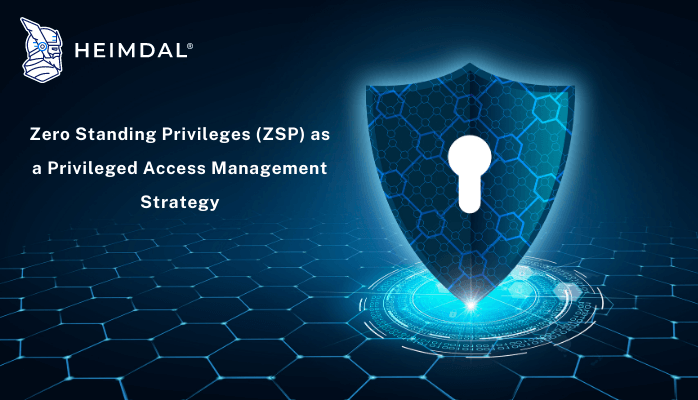Contents:
In this article, we explore Zero Standing Privileges (ZSP), a straightforward yet effective approach to managing access rights in network security.
Local administrator accounts, shared accounts, superusers, root accounts, and never-off-boarded 3rd party privileges all contribute to the growth of the attack surface of an organization.
To keep all that in order and safe from cyber threats, System Administrators who deal with large, complex digital environments usually rely on an automated privileged access management solution.
What Are Standing Privileges?
A standing privilege is any high-level right that a user can access without the need to require privileged access. Through standing privileges, a user can have perpetual access to critical IT resources. Even if they’re not using them at the time or don’t need them at all to perform their tasks – access to those privileges is always on.
Best practices in privileged access management state that each user should only have the exact privileges they need to do their job and nothing more. This is called the Principle of Least Privilege (POLP) and is one of the core philosophies of a Zero-trust model.
As opposed, standing privileges enable any user with a login ID to access a resource.
What Are Zero Standing Privileges (ZSP)?
ZSP, or Zero Standing Privileges, is a term first introduced by Gartner, advocating for increased IT security by removing standing privileges in the form of accounts that have administrative rights. The existence of such accounts carries significant risk by increasing the attack surface for privilege abuse.
So, in other words, Zero Standing Privileges (ZSP) is an approach to privilege management in which a user is only granted the bare minimum permissions needed to perform their job. This is in contrast to the more common approach of granting users broad permissions and then relying on access control mechanisms to limit what they can do.
Removing standing privileges accounts is ideal but not always possible. In fact, they should be secured, and access should be limited based on need-to-know, with a workflow-based access request and approval mechanism. This ensures that the account is only available to legitimate actors when needed.
Overall, ZSP is a trade-off between security and usability. It’s important to weigh the risks and benefits carefully before implementing this approach in your organization, but more on that later on.
How Can ZSP Be Implemented?
Zero Standing Privileges (ZSP) is a security concept that can be implemented in various ways, but the general idea is to limit the privileges of user accounts and give them only the bare minimum permissions they need to perform their jobs. With ZSP in place, even if a malicious user were to gain access to an account with elevated privileges, they would not be able to do much damage since those privileges would have been removed.
There are a few different ways to implement ZSP, but one common approach is through least privilege Access Control Lists (ACLs). With least privilege ACLs in place, users are only given the permissions they absolutely need to perform their jobs – no more and no less. This can be accomplished through Role-Based Access Control (RBAC), which assigns permissions to users based on their job function.
Another way to implement ZSP is through application whitelisting. With this approach, only trusted applications are allowed to run on a system – all others are blocked. This can help prevent malicious software from being installed and executed, as well as limiting what privileged users can do.
Just-in Time Access (JIT) vs. Zero Standing Privileges (ZSP)
With Just-in-Time (JIT) privileged access management, you don’t need to worry about continuous access. This strategy is designed to limit the privileges of an account when it no longer needs them. Privileges come into existence just before they’re needed and are quickly revoked afterwards. You can also decide how long a privilege will last depending on what its purpose is.
Now this is where the main distinction happens: the window of opportunity in which the privilege is active is limited to a few moments over a long period of time with JIT access, while in the case of standing privileges, they are distributed indefinitely. This means that this opportunity provides constant access.
JIT privileges are available anytime, anywhere, it just depends on when and where they’re needed. When you apply this across all your admins, the impact is tremendous: the threat window during which your privileges are vulnerable will be much smaller, which leads to a considerable increase in security.
When you have zero standing privileges, it means that all admin access is restricted to the minimum amount of time needed. A realized ZSP strategy is the best possible outcome of a JIT approach to privilege management.
Disadvantages of ZSP
There are many benefits to implementing ZSP, but perhaps the most important is that it can help prevent data breaches and limit the scope of damage that can be done if one does occur. Additionally, by reducing the number of privileged accounts within an organization, ZSP can also make it easier to manage permissions and reduce the overall attack surface.
However, there are also some disadvantages to ZSP worth noting, such as:
- First, ZSP can potentially increase the amount of time needed to complete certain tasks. This is because ZSP requires that users have no privileges whatsoever when they are working with sensitive data. This means that every task must be completed with explicit permission from a privileged user. This can add significant overhead, particularly in organizations with large numbers of users.
- Second, ZSP can also make it more difficult to troubleshoot problems. This is because privileged users are not able to access data or systems that they do not have explicit permission for. This can make it difficult to track down the source of a problem or identify potential solutions.
- With ZSP the risk of data breaches is not completely out of the picture. This is because privileged users are not able to access data or systems that they do not have explicit permission for. If a malicious user gains access to a system through an unprivileged account, they may be able to escalate their privileges and gain access to sensitive data.
- ZSP can also make it more difficult to manage complex environments, because privileged users are not able to access data or systems that they do not have explicit permission for. This can make it difficult to keep track of what changes have been made and ensure that all systems are properly configured.
- Finally, ZSP can also increase the cost of implementing and maintaining security controls. This is because privileged users are not able to access data or systems that they do not have explicit permission for. This can make it more expensive to implement and maintain security controls such as firewalls and intrusion detection systems.
How Can Heimdal® Help?
Our Privileged Access Management solution is remarkable due to its characteristics:
- When used together with our Nex-Gen Antivirus, it turns into the only software that automatically de-escalates user rights, in case there are threats are detected.
- Stunning, lightweight interface giving you complete control over the user’s elevated session. Approve or deny from the dashboard or on the go right from your mobile device.
- You have the Zero – Trust Execution Protection display in the Privileges & App Control – Privileged Access Management view, that includes many details like the processes (non-signed executable files) that the zero-trust execution protection engine intercepted, with data on Hostname, Username, Process Name, MD5 Hash, Timestamp, and Status.
- Advanced data analytics that will help investigate incidents and perform regular security checkups. Obtain graphic-rich reports on hostname details, average escalation duration, users or files escalated, files or processes ran during escalation, and more.
Further, you can add our Application Control module into the mix, and you will be able to perform application execution approval or denial or live session customization to further ensure business safety.
A well implemented PAM policy regarding the management of privileges is a fundamental aspect of any cybersecurity strategy. Make sure you have the proper PAM tool and be a step ahead of hackers!

Heimdal® Privileged Access Management
- Automate the elevation of admin rights on request;
- Approve or reject escalations with one click;
- Provide a full audit trail into user behavior;
- Automatically de-escalate on infection;
Conclusion
Zero Standing Privileges (ZSP) is a revolutionary way to protect your network. When you go with ZSP, users won’t have administrative access and will instead gain privileges as they need them. This means that overprivileged users can’t wreak havoc on your network—their access is temporary and monitored.
With no surface area for cyberattacks, ZSP provides an effective defense system against vulnerabilities, which makes it a crucial part of PAM best practices. Furthermore, zero standing privileges is a great way to ensure that your employees are productive and focused while at work. By implementing ZSP in your organization, you can encourage a culture of respect and accountability amongst your teams.
If you enjoyed this article, follow us on LinkedIn, Twitter, Facebook, Youtube, or Instagram to keep up to date with everything we post!


 Network Security
Network Security
 Vulnerability Management
Vulnerability Management
 Privileged Access Management
Privileged Access Management
 Endpoint Security
Endpoint Security
 Threat Hunting
Threat Hunting
 Unified Endpoint Management
Unified Endpoint Management
 Email & Collaboration Security
Email & Collaboration Security










